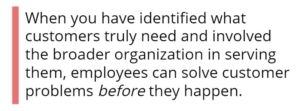There’s no doubt about it – culture change is sexy. So sexy, that it’s where most customer experience programs focus. But starting with culture is putting the cart before the horse. And we all know you’re not going to get anywhere that way.
In this final post in my CX-focused series on applying John Kotter’s 8 Steps to Accelerate Change in Your Organization, we cover the eighth step: Institute Change.
The problem is that most employees believe they’re doing the right thing for customers – it’s those people in [insert name of some other department] who are messing up. So if you start with culture change – putting together training, creating a customer room, waiting for improved outcomes – you’re loading your cart before you have the means to propel it forward.
First things first
You can’t change culture until you create better behaviors. So start there. Develop your capabilities to focus on customers, help employees understand what is going wrong today, and show them how they can better serve customers.
Kotter’s first seven steps – creating a sense of urgency, building a guiding coalition, forming a strategic vision, enlisting a volunteer army, removing barriers, generating short-term wins, and sustaining acceleration – help you build the customer-focused muscles you’ll need to meet this challenge.
Think of those steps as endurance training. They build the capabilities needed for embedding these new behaviors into the culture. You wouldn’t attempt a marathon on your first run, would you? Or without the appropriate footwear?

Those foundational steps helped you identify your champions. Use these early adopters – the ones who not only believe in customer focus but help the organization act differently – to institute change.
Note: In this context, be sure not to confuse “champions” with “heroes.” Many organizational cultures serve customers through heroes – people who make extraordinary efforts (too often risking burnout in the process) to help customers. But the irony of an effective culture is that it de-emphasizes those kinds of heroics…because realistically, they’re just not scalable.
To create a change-friendly climate, identify those champions who are leading today’s efforts to improve the experience. Then use them to inspire the rest, building solid processes that don’t require working weekends to fix a customer’s problem. This way, everyone gets the chance to be hero and still have a life.
Fitting all the pieces together
When you have identified what customers truly need and involved the broader organization in serving them, employees can solve customer problems before they happen. That’s a win for everyone.
Too many CX programs wither because they fall into the trap of trying to “boil the ocean.” When you’re spread that thin, you’re not going to be able to show continual impact. So be strategic and disciplined in your efforts. Focus first on building an improved approach to serving customers. Then drive lasting change effectively, propelled by your newfound ability to show how customer-centricity improves business outcomes.
Believe me, I get it. When first starting out, building a training on what customers want can seem like a great way to make an immediate impact. But even if it does manage to do that, the impact will be short-lived.
In the long run, it’s far more effective to first discover where customer and business success intersect to prove out your case. Begin with Kotter’s first seven steps to build your capabilities. Only then should you move ahead with building your training and other culture change efforts.
Remember, driving customer-focused change is a marathon, not a sprint.



